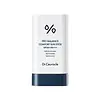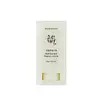What's inside
What's inside
 Key Ingredients
Key Ingredients

 Benefits
Benefits

 Concerns
Concerns

 Ingredients Side-by-side
Ingredients Side-by-side

1,2-Hexanediol
Skin ConditioningAdenosine
Skin ConditioningAlumina
AbrasiveAvena Sativa Kernel Extract
AbrasiveBeta-Glucan
Skin ConditioningBifida Ferment Filtrate
Skin ConditioningBis-Ethylhexyloxyphenol Methoxyphenyl Triazine
Skin ConditioningButyloctyl Salicylate
Skin ConditioningC18-21 Alkane
SolventCamellia Sinensis Leaf Water
MaskingCaprylic/Capric Triglyceride
MaskingCaprylyl Glycol
EmollientCynara Scolymus Leaf Extract
Skin ConditioningDibutyl Adipate
EmollientDicaprylyl Carbonate
EmollientDiethylamino Hydroxybenzoyl Hexyl Benzoate
UV FilterDiisopropyl Sebacate
EmollientDimethicone
EmollientDipropylene Glycol
HumectantEthylhexyl Triazone
UV AbsorberEthylhexylglycerin
Skin ConditioningFructooligosaccharides
HumectantGlutathione
Glycerin
HumectantGlyceryl Caprylate
EmollientHydrogenated Lecithin
EmulsifyingIsopropyl Palmitate
EmollientLactobacillus Ferment
Skin ConditioningLactobacillus Ferment Lysate
Skin ConditioningLactobacillus/Acerola Cherry Ferment
Skin ProtectingLactobacillus/Punica Granatum Fruit Ferment Extract
Skin ConditioningLactobacillus/Soybean Ferment Extract
Skin ConditioningLactococcus Ferment
Skin ConditioningLactococcus Ferment Lysate
Skin ConditioningLauryl Polyglyceryl-3 Polydimethylsiloxyethyl Dimethicone
Skin ConditioningLeuconostoc/Radish Root Ferment Filtrate
AntimicrobialMethylpropanediol
SolventMilk Lipids
Skin ConditioningNiacinamide
SmoothingOryza Sativa Bran Oil
EmollientOzokerite
Emulsion StabilisingPoly C10-30 Alkyl Acrylate
Emulsion StabilisingPolyglyceryl-4 Diisostearate/Polyhydroxystearate/Sebacate
EmulsifyingPolyglyceryl-5 Polyricinoleate
EmulsifyingPolyhydroxystearic Acid
EmulsifyingPolyquaternium-51
Skin ConditioningSodium Chloride
MaskingStearic Acid
CleansingSynthetic Wax
AbrasiveTheanine
EmollientTitanium Dioxide
Cosmetic ColorantTocopherol
AntioxidantVinyl Dimethicone/Methicone Silsesquioxane Crosspolymer
Water
Skin Conditioning1,2-Hexanediol, Adenosine, Alumina, Avena Sativa Kernel Extract, Beta-Glucan, Bifida Ferment Filtrate, Bis-Ethylhexyloxyphenol Methoxyphenyl Triazine, Butyloctyl Salicylate, C18-21 Alkane, Camellia Sinensis Leaf Water, Caprylic/Capric Triglyceride, Caprylyl Glycol, Cynara Scolymus Leaf Extract, Dibutyl Adipate, Dicaprylyl Carbonate, Diethylamino Hydroxybenzoyl Hexyl Benzoate, Diisopropyl Sebacate, Dimethicone, Dipropylene Glycol, Ethylhexyl Triazone, Ethylhexylglycerin, Fructooligosaccharides, Glutathione, Glycerin, Glyceryl Caprylate, Hydrogenated Lecithin, Isopropyl Palmitate, Lactobacillus Ferment, Lactobacillus Ferment Lysate, Lactobacillus/Acerola Cherry Ferment, Lactobacillus/Punica Granatum Fruit Ferment Extract, Lactobacillus/Soybean Ferment Extract, Lactococcus Ferment, Lactococcus Ferment Lysate, Lauryl Polyglyceryl-3 Polydimethylsiloxyethyl Dimethicone, Leuconostoc/Radish Root Ferment Filtrate, Methylpropanediol, Milk Lipids, Niacinamide, Oryza Sativa Bran Oil, Ozokerite, Poly C10-30 Alkyl Acrylate, Polyglyceryl-4 Diisostearate/Polyhydroxystearate/Sebacate, Polyglyceryl-5 Polyricinoleate, Polyhydroxystearic Acid, Polyquaternium-51, Sodium Chloride, Stearic Acid, Synthetic Wax, Theanine, Titanium Dioxide, Tocopherol, Vinyl Dimethicone/Methicone Silsesquioxane Crosspolymer, Water
Methyl Methacrylate Crosspolymer
Synthetic Wax
AbrasiveDibutyl Adipate
EmollientCoco-Caprylate/Caprate
EmollientIsopropyl Palmitate
EmollientCaprylyl Methicone
Skin ConditioningCaprylyl Trimethicone
Skin ConditioningEthylhexyl Palmitate
EmollientSilica
AbrasiveVinyl Dimethicone/Methicone Silsesquioxane Crosspolymer
Diethylamino Hydroxybenzoyl Hexyl Benzoate
UV FilterBis-Ethylhexyloxyphenol Methoxyphenyl Triazine
Skin ConditioningBoron Nitride
AbsorbentButyloctyl Salicylate
Skin ConditioningEthylhexyl Triazone
UV AbsorberMicrocrystalline Wax
Emulsion StabilisingPolysilicone-15
UV FilterVinyldimethicone
Camellia Japonica Seed Oil
EmollientPolyglyceryl-4 Diisostearate/Polyhydroxystearate/Sebacate
EmulsifyingCurcuma Longa Root Extract
MaskingMelia Azadirachta Flower Extract
Skin ConditioningMelia Azadirachta Leaf Extract
Skin ConditioningCorallina Officinalis Extract
Skin ConditioningMelia Azadirachta Bark Extract
AntimicrobialOcimum Sanctum Leaf Extract
Skin ConditioningMoringa Oleifera Seed Oil
EmollientCoccinia Indica Fruit Extract
Skin ConditioningSolanum Melongena Fruit Extract
Skin ConditioningAmber Powder
Water
Skin ConditioningAloe Barbadensis Flower Extract
EmollientSimmondsia Chinensis Seed Oil
Emollient1,2-Hexanediol
Skin ConditioningArtemisia Capillaris Extract
Camellia Sinensis Seed Oil
HumectantHyaluronic Acid
HumectantPanthenol
Skin ConditioningButylene Glycol
HumectantPropanediol
SolventBambusa Vulgaris Extract
Skin ConditioningCamellia Sinensis Leaf Extract
AntimicrobialGlycerin
HumectantMethylpropanediol
SolventCentella Asiatica Extract
CleansingMorinda Citrifolia Extract
AstringentVigna Radiata Seed Extract
Skin ConditioningEthylhexylglycerin
Skin ConditioningMethyl Methacrylate Crosspolymer, Synthetic Wax, Dibutyl Adipate, Coco-Caprylate/Caprate, Isopropyl Palmitate, Caprylyl Methicone, Caprylyl Trimethicone, Ethylhexyl Palmitate, Silica, Vinyl Dimethicone/Methicone Silsesquioxane Crosspolymer, Diethylamino Hydroxybenzoyl Hexyl Benzoate, Bis-Ethylhexyloxyphenol Methoxyphenyl Triazine, Boron Nitride, Butyloctyl Salicylate, Ethylhexyl Triazone, Microcrystalline Wax, Polysilicone-15, Vinyldimethicone, Camellia Japonica Seed Oil, Polyglyceryl-4 Diisostearate/Polyhydroxystearate/Sebacate, Curcuma Longa Root Extract, Melia Azadirachta Flower Extract, Melia Azadirachta Leaf Extract, Corallina Officinalis Extract, Melia Azadirachta Bark Extract, Ocimum Sanctum Leaf Extract, Moringa Oleifera Seed Oil, Coccinia Indica Fruit Extract, Solanum Melongena Fruit Extract, Amber Powder, Water, Aloe Barbadensis Flower Extract, Simmondsia Chinensis Seed Oil, 1,2-Hexanediol, Artemisia Capillaris Extract, Camellia Sinensis Seed Oil, Hyaluronic Acid, Panthenol, Butylene Glycol, Propanediol, Bambusa Vulgaris Extract, Camellia Sinensis Leaf Extract, Glycerin, Methylpropanediol, Centella Asiatica Extract, Morinda Citrifolia Extract, Vigna Radiata Seed Extract, Ethylhexylglycerin
 Reviews
Reviews

Ingredients Explained
These ingredients are found in both products.
Ingredients higher up in an ingredient list are typically present in a larger amount.
1,2-Hexanediol is a synthetic liquid and another multi-functional powerhouse.
It is a:
- Humectant, drawing moisture into the skin
- Emollient, helping to soften skin
- Solvent, dispersing and stabilizing formulas
- Preservative booster, enhancing the antimicrobial activity of other preservatives
You might know this ingredient as Tinosorb S or Bemotrizinol. It is a UV filter that covers both UVA and UVB rays.
This ingredient has two peak UV absorption peaks ( 310 and 340 nm) and is able to absorb both UV-A and UV-B rays. This ingredient works by preventing UV rays from reaching and damaging your skin.
On top of that - it is highly photostable and helps prevent the photodegration of other sunscreen ingredients such as avobenzone.
Tinosorb S is allowed in the EU, Australia, and Asia. It is close to being approved by the FDA and we'll hopefully get this ingredient in the U.S. by late 2025.
Fun fact: Tinosorb S is the most effective UV absorber at maximum concentration (measured by SPF) permitted in the EU.
This ingredient is oil-soluble, so your oil-cleansers will take this right off at night.
Learn more about Bis-Ethylhexyloxyphenol Methoxyphenyl TriazineButyloctyl Salicylate is a chemical UV filter structurally similar to octisalate. It is a photostabilizer, SPF booster, emollient and solvent. This ingredient helps evenly spread out ingredients.
According to a manufacturer, it is suitable for pairing with micro Titanium Dioxide, Zinc Oxide, and pigments.
Photostabilizers help stabilize UV-filters and prevents them from degrading quickly.
Learn more about Butyloctyl SalicylateDibutyl Adipate is an emollient and solvent. It is created from butyl alcohol and adipic acid.
As a solvent, Dibutyl Adipate helps mix and disperse ingredients evenly.
Dibutyl Adipate is soluble in water and organic solvents. It does not absorb UV rays.
Learn more about Dibutyl AdipateDiethylamino Hydroxybenzoyl Hexyl Benzoate (DHHB) is a chemical UV-A absorber. It is formulated for high UVA protection (320-400 nm).
DHHB is well-liked for:
DHHB has been approved by the EU, Japan, Taiwan, and South America for use up to 10%. Unfortunately, it has not been approved for use in the US or Canada due to slow regulatory processes.
This ingredient is soluble in oils, fats, and lipids.
Learn more about Diethylamino Hydroxybenzoyl Hexyl BenzoateEthylhexyl Triazone is a modern chemical sunscreen that protects from UV-B radiation.
It is the most effective of existing UV-B filters, as it provides the highest level of photo-stable absorption. It protects from the entire UV-B range (280 to 320nm), with it's highest level of protection at 314nm.
Ethylhexyl Triazone is oil soluble, oderless and colorless, which mean it is able to be incorporated into a variety of different formulations.
It is not currently available within the United States due to slow changing FDA regulations. Outside of the US, it is used in formulations at concentrations up to 5%.
Learn more about Ethylhexyl TriazoneEthylhexylglycerin (we can't pronounce this either) is commonly used as a preservative and skin softener. It is derived from glyceryl.
You might see Ethylhexylglycerin often paired with other preservatives such as phenoxyethanol. Ethylhexylglycerin has been found to increase the effectiveness of these other preservatives.
Glycerin is already naturally found in your skin. It helps moisturize and protect your skin.
A study from 2016 found glycerin to be more effective as a humectant than AHAs and hyaluronic acid.
As a humectant, it helps the skin stay hydrated by pulling moisture to your skin. The low molecular weight of glycerin allows it to pull moisture into the deeper layers of your skin.
Hydrated skin improves your skin barrier; Your skin barrier helps protect against irritants and bacteria.
Glycerin has also been found to have antimicrobial and antiviral properties. Due to these properties, glycerin is often used in wound and burn treatments.
In cosmetics, glycerin is usually derived from plants such as soybean or palm. However, it can also be sourced from animals, such as tallow or animal fat.
This ingredient is organic, colorless, odorless, and non-toxic.
Glycerin is the name for this ingredient in American English. British English uses Glycerol/Glycerine.
Learn more about GlycerinIsopropyl Palmitate is a texture enhancer and emollient. It is an ester of isopropyl alcohol and palmitic acid.
Palmitates are emollients. Emollients help keep your skin soft and smooth by creating a barrier that traps moisture in.
When added to cosmetics, Isopropyl Palmitate creates a silky texture and improves spreadability.
Isopropyl Palmitate may not be fungal acne safe. It can worsen acne prone skin.
Learn more about Isopropyl PalmitateMethylpropanediol is a synthetic solvent and humectant.
As a solvent, it helps dissolve other ingredients, helping to evenly distribute ingredients throughout the product. This ingredient has also been shown to have antimicrobial properties which makes it a preservative booster.
Methylpropanediol is able to add a bit of moisture to the skin. It also helps other ingredients be better absorbed into the skin, such as salicylic acid.
Learn more about MethylpropanediolPolyglyceryl-4 Diisostearate/Polyhydroxystearate/Sebacate isn't fungal acne safe.
Synthetic Wax is created from fossil fuels such as natural gas. It is used to enhance texture, adjust pH, and as an occlusive.
It may also be used as an abrasive ingredient to exfoliate the skin.
Synthetic Wax may not be fungal acne safe.
Learn more about Synthetic WaxThis ingredient is used in makeup and skincare to thicken formulas, reduce shine, and give skin a silky-smooth feel.
It’s a white silicone powder that sits in fine lines and pores to blur their appearance though its effectiveness depends on the particle size.
You'll typically find this ingredient in amounts between 0.1-20%.
Learn more about Vinyl Dimethicone/Methicone Silsesquioxane CrosspolymerWater. It's the most common cosmetic ingredient of all. You'll usually see it at the top of ingredient lists, meaning that it makes up the largest part of the product.
So why is it so popular? Water most often acts as a solvent - this means that it helps dissolve other ingredients into the formulation.
You'll also recognize water as that liquid we all need to stay alive. If you see this, drink a glass of water. Stay hydrated!
Learn more about Water